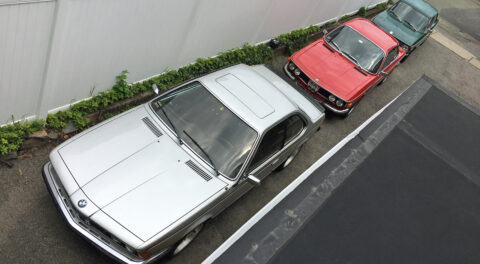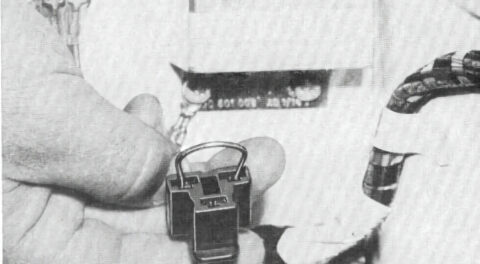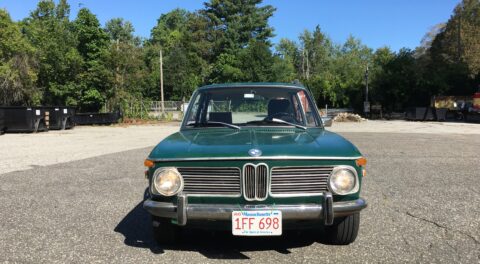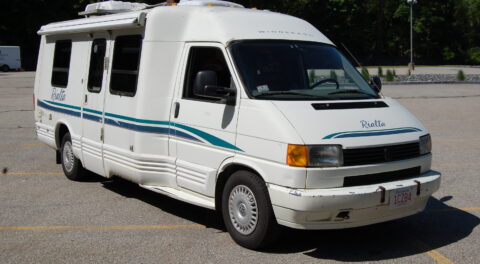Over the 37 years I’ve owned it, I’ve written quite a bit about my 1973 E9 3.0CSi, including a three-part series in Roundel in 1988 titled “The Life, Death, and Life of a Coupe,” and revisiting the car’s not-quite-a-restoration in my book Memoirs of a Hack Mechanic. However, while I was scanning the family slides last week, I discovered some missing-link-like photos of the car I didn’t know existed. So, here’s a short illustrated history featuring some never-seen-before pics.
I’d already gone through about a dozen 2002s when I bought the dead, partially-disassembled Polaris / Navy 3.0CSi for $1,700 in 1986. I craved an E9, and this was the only one I could afford. Back then, nice E9s didn’t reach the six-figure stratosphere they do today, but their prices never really dipped like 2002s did; they were always ten grand or more for presentable cars. The fact that this one had been cracked in the nose and had the glass and the interior out of it didn’t scare me. It was like buying an old house that needs your sweat equity.
I wish I could find a photo of the car when the tow truck dropped it off in front of my mother’s house in Brighton where my wife Maire Anne and I lived (we had the 3rd floor apartment). The gentleman who lived across the street was a car guy—he had an MGTD and a new Series III Alfa Spider—but he didn’t know this car. As the tow truck’s slide-back ramp disgorged the car with its mangled nose, missing glass and interior, and dents in most body panels, he said “Is that supposed to be worth something?”
The guy I bought the car from worked at the BMW dealership Foreign Motors West in Natick. If I recall correctly, he learned that the car had been originally purchased in Italy and was brought to the United States, but was never federalized. I’m unclear on the exact history regarding the accident damage, but the car needed a nose, fenders, and a hood, and the guy that he bought it from had tried to booge his way through the bodywork. If you look closely at this photo of the right side if the car, you can see how the partially-crumpled fender was stretched back, overlapped, and pop-riveted to itself. You can also see the slightly-bowed hood, and some light sideswipe damage to the right rear quarter panel and door.
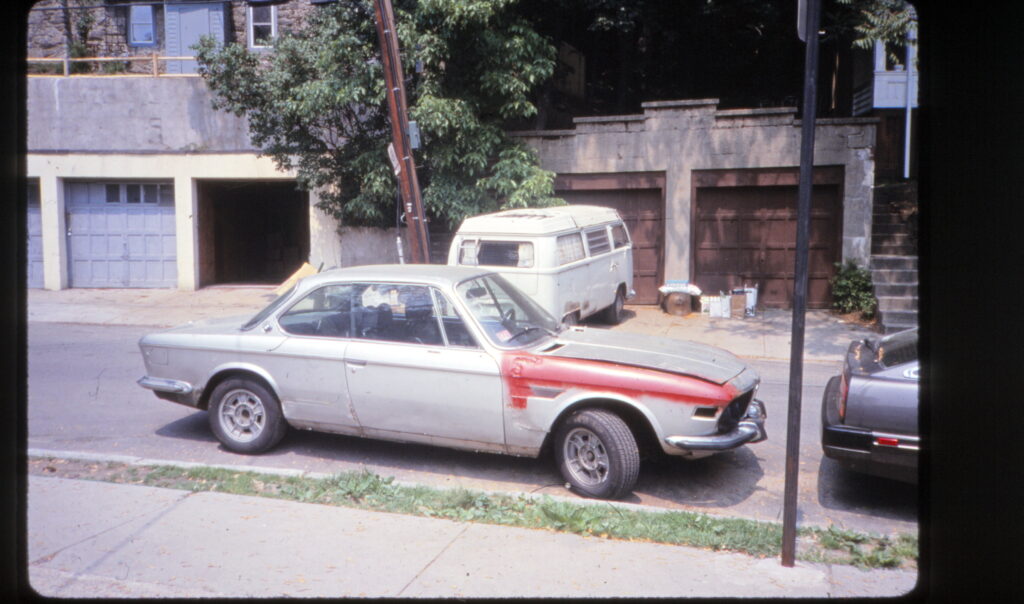
She was cheap and solid, but definitely not a head-turner.
Nowadays, every vintage BMW fan knows that E9s are legendary rust buckets, hiding their dark dirty secrets in places that are not easy to inspect (I wrote it about it in detail here). Back then, I didn’t know what I know now about how E9s rust, but the fact that this car wasn’t wearing its wide rocker panel covers meant that at least those sections could be easily inspected. Long story short, I was simply lucky. The car was a basket case, but it turned out to be an incredibly solid one. I figured that I could get it running, begin driving it, and do something like a rolling restoration decades before that was even a term.
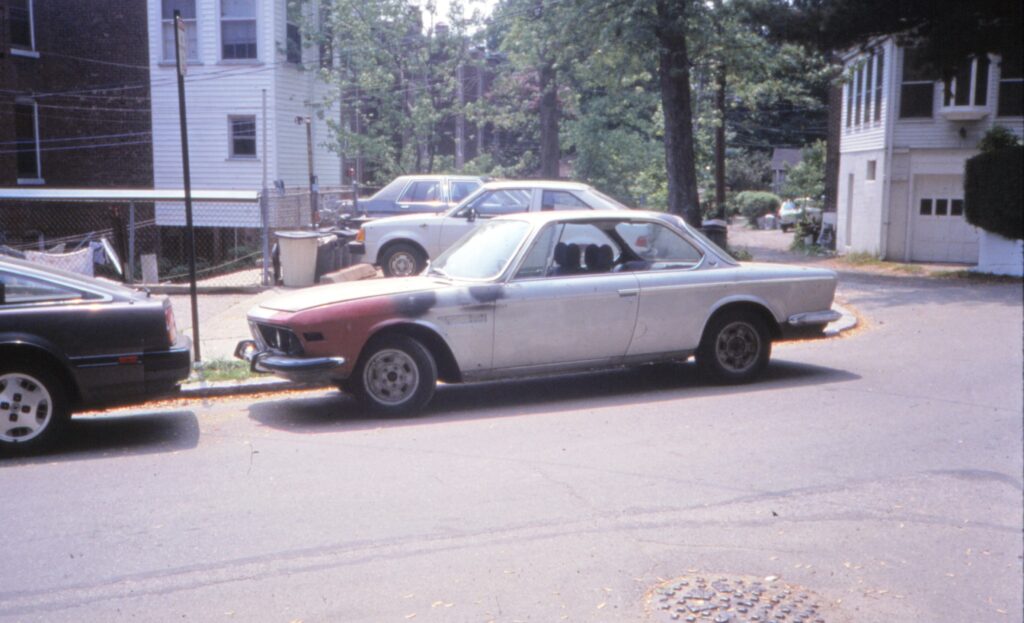
Not really any better from the left. Yes, I know that the bumper overriders are upside down.
And so I did. I was a man short on money, but long on vision. A previous owner had already replaced the car’s Bosch D-Jetronic fuel injection with dual Weber 32/36s, so I never needed to plumb the D-Jet’s arcane mysteries. I whacked away at the car, reinstalling the glass and the interior and doing the mechanical odds and ends necessary to revive it like any dormant beast. It ran, but was tired; the engine burned oil and felt anemic, and the car’s entire vibe was more truck-like than grand tourer-like.
Nevertheless, I owned a solid, running E9, and I was beyond thrilled. I had a five-mile commute to work, and delighted in driving the car as often as possible, showing it off to my horrified non-car colleagues and the one or two people who cared. I was a walking “LET ME TELL YOU ABOUT MY E9” bumper sticker.
Through ads in Roundel and the CS Register newsletter, I found sources for the body panels. I held off on replacing the hood, hoping that it could instead be straightened. I solicited quotes for the nose and fenders from Bimmer Parts and The Illuminescence Group. Illuminescence was a little cheaper. I wrote them a check for about $1,400. Nowadays, I think that’s the cost of even looking at an E9 fender.

Ah, those were the days.
I brought the car and the sheet metal to Dave Elbery in nearby Natick. His shop, Elbery Auto Body, was behind BMW CCA founding member Michel Potheau’s legendary Circle Tire shop. Elbery’s did metal work on BMWs back when patch-and-paint was part of the maintenance of a daily driver and not something that required you to take out a second mortgage. As I describe in the “Where E9 coupes rust” piece I linked to above, part of the E9’s rust-monster reputation is the double whammy that a) There’s a cavity up under the front shock towers where dirt and moisture accumulate, causing them to rot out from the inside, and b) To expose this area, you need to remove the front fenders, and they’re not bolted on like they are on virtually every other BMW. Instead, the fenders are lap-seamed at the corners of the windshield, so the windshield has to come out to remove them. It’s very common for the windshield to crack when removing it, and mine did. Elbery cut the nose and fenders off, patched a small rust hole underneath, grafted the new panels on, and straightened the hood. The bill was $2,300, which included a new OEM windshield. So, including the body panels, Phase II of operation Revive The E9 came to about $3,700. This was all the money I had in the world at that time, so I stopped. I drove the car that way for another year.

The E9 wearing its one-year-only Polaris-and-primer livery on a weekend with some friends up in New Hampshire.
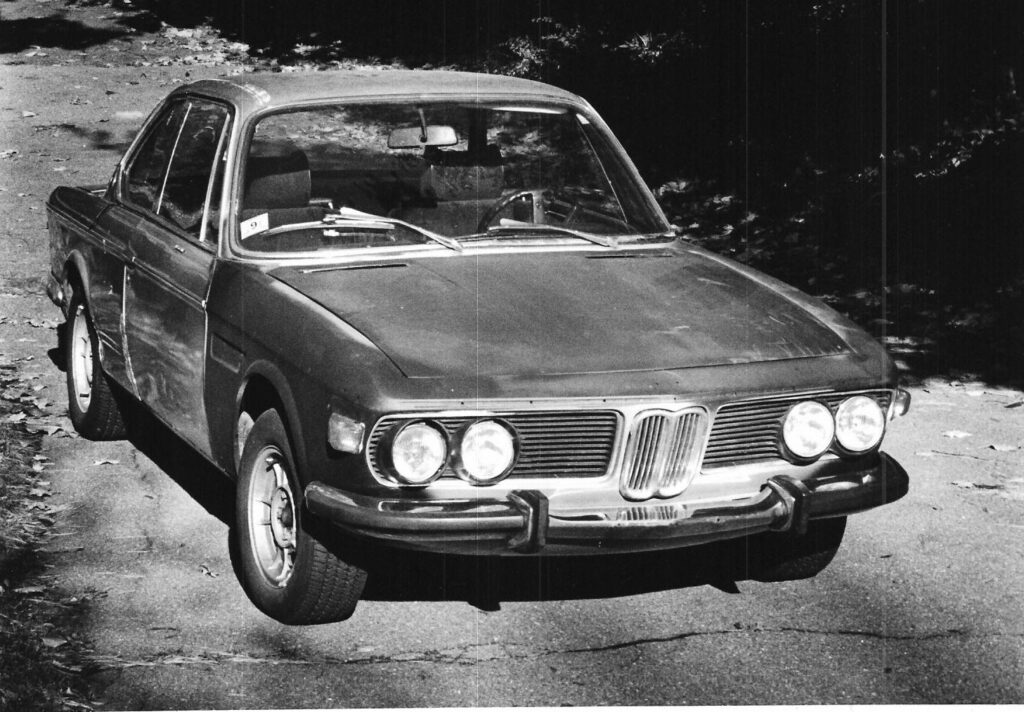
Another pic of the car in its intermediate state, this one taken by Yale Rachlin and used in the original Roundel series on the car in 1988.
As we approached 1988, Maire Anne was pregnant with our first child. It made absolutely no sense for me to push forward on getting the car painted.
I did it anyway.
In hindsight, I’m utterly astonished by this, especially considering that my Hack Mechanic worldview has evolved into one where I say over and over that restoration is a fool’s game; that if you want a pretty shiny car you should buy a pretty shiny car and not try to make a silk purse out of a sow’s ear, and that if you can’t afford a pretty shiny car, tough stuff, suck it up, the world is full of things you can’t have, and it’s far easier on the wallet to live with patina anyway. With hindsight, I now understand the degree to which this philosophy came directly from the experience with the E9, but it’s called perspective because we don’t have it when we’re standing right in the middle of something.
Giovanni’s BMW Auto Body in Peabody Massachusetts was active in the Boston BMW CCA chapter and seemed to have a good reputation. When I visited the shop, I found that Giovanni had his own E9 that he was working on, as well as a heavily-modified ’74 tii. The $4,000 he quoted me for a glass-out bare-metal respray, including repainting the engine compartment, trunk, and floor pans, seemed nosebleed-worthy, but at the time it was the best price I could find for this kind of job. It bought sanding down to metal, skim-coating with body filler to level the panels, and painting with seven coats of urethane and seven coats of clear (Giovanni strongly recommended base coat / clear coat as opposed to a straight color), all wet-sanded to remove orange peel and get the paint to lie flat.
Of course, I still didn’t have $4,000, so I did what any rational person expecting his first child would do—I took out an unsecured personal loan from the local bank. Nuts, right? There was actually a bit of method behind my madness. Maire Anne and I knew that, at some point, we’d want to move out of the 3rd floor of my mother’s house and buy a place of our own. I had virtually no credit history. This was an opportunity to establish one.
Color-wise, I had it in my head that I wanted to repaint the car red. I mean, what 29-year-old wouldn’t want to repaint the car red? Again, these cars weren’t worth what they’re worth now, and the howls from the purists regarding color-changing a car couldn’t yet be heard from deep within their caves. I saw a red mid-80s Mercedes 560SL and loved the color. I learned that it was Signal Red—slightly richer and deeper than the Verona red that BMW used on E9s. Giovanni cautioned me on two things. First, since the Mercedes had a good deal of black trim whereas the trim on the E9 was mostly chrome, the color wouldn’t look quite as dark on the E9, Second, any old, faded, pitted trim would look terrible against the new paint. So down the rabbit hole I went, procuring all new exterior trim and rubber.
Below are some of the slides that I was stunned to find. There are two ways to look at them. One is to nitpick at the fact that the engine was covered rather than removed, at the amount of body filler used, and at the amount of overspray. The other is to marvel that, with our first child approaching, any of this got done at all. I’m firmly in the latter camp. If you’re a do-it-once-do-it-right person and this offends your automotive soul, you are more than welcome to time-travel back to 1988 and give me the money. Tell you what—we’ll leave the car alone, invest the money in Apple stock, and split the profit.

These photos show the original Navy velour interior still installed. It was eventually removed so the interior could be sprayed in the new color.

Yes, the engine was left in and painted around. Don’t judge me. Okay, judge me. I really don’t care.
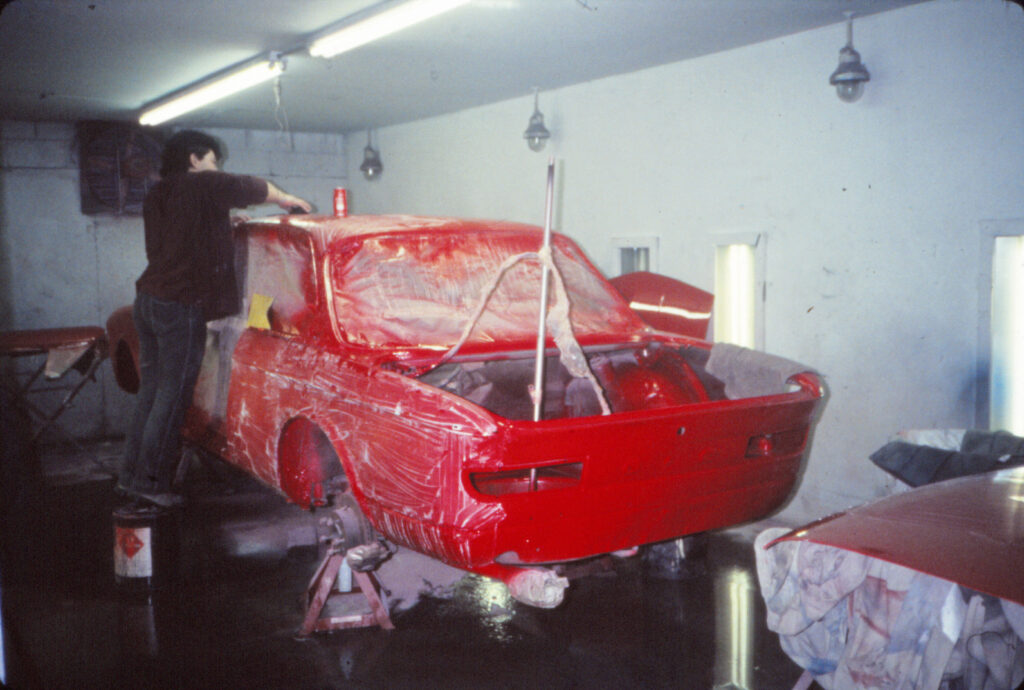
Yes, I know—the amount of overspray on the tailpipe is laughable. It burned off. You can still see the overspray on the fender wells.
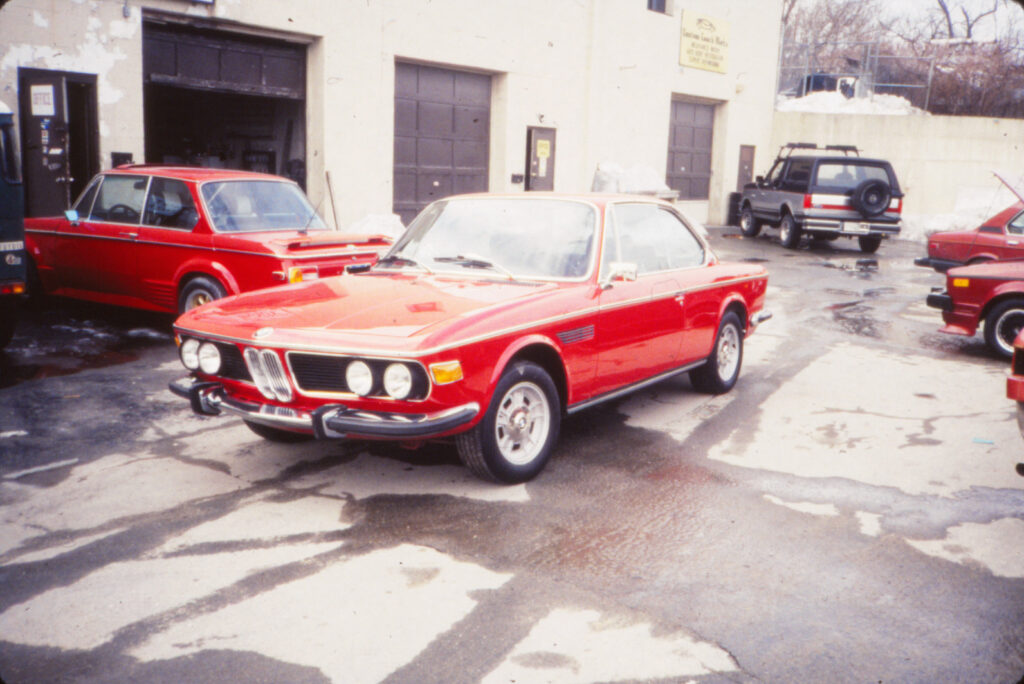
Ta-DA!
The completed car with the fresh trim and rubber was simply stunning. The absolutely-true story I’ve told for decades is that I, who looked like a young skinny Jerry Garcia, was driving the car to work when a middle-aged guy in a 911 Carrera pulled up next to me at a stoplight.
“Wow,” he said. “Gorgeous car!”
“Thanks.”
Then he spoke his mind. “How does a guy like you afford a car like that?”
“Drugs,” I said, and drove off.
In the 1988 three-part Roundel article, I nut-shelled the costs as follows:
| initial purchase | $1,700 |
| parts car | $800 |
| new nose and fenders | $1,400 |
| new chrome and rubber trim | $1,400 |
| bodywork and paint | $6,700 |
| mechanicals | $1,700 |
| total | $13,700 |
Back then, I looked at that pragmatically, thinking “I could sell it for about what I have in it, so I did okay.” Now, I marvel at how lucky I was to thread the needle and get this done while a baby was being dropped into our life.
I never really liked the Navy velour interior against the new red paint. Fortunately I didn’t have to live with it long, because not long after the E9 was painted, I found another rust-free E9—a rare 1975 (yes that’s correct) that had been sold into Saudi Arabia, then imported here. And it had a tan leather interior. Unfortunately—at least in terms of generating tough choices—it also had working air conditioning, and it was a much more solid-feeling car, thunk-clunk-and-rattle-wise. However, I couldn’t sell the car I’d just had painted, so I swapped interiors, giving me the red-on-beige look I wanted.
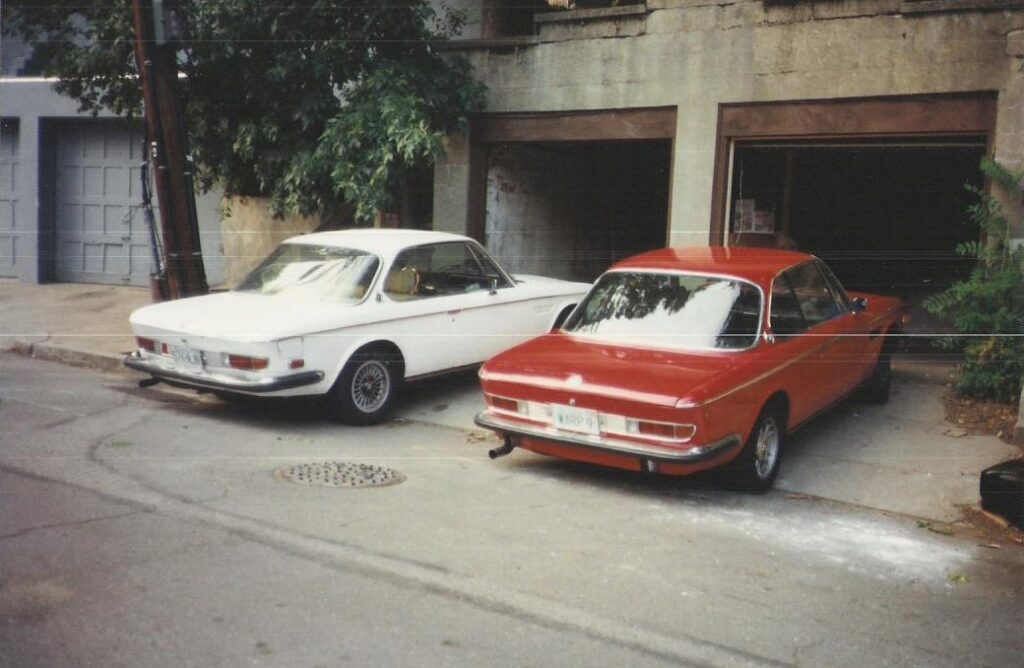
Tough choice. I picked the babe on the right.
That was pretty much it in terms of the “restoration” (I hate that term) of the car. Since 1988, I’ve been careful with the car. Other than a few scratches, it still looks pretty much like it did after it was painted in 1988, and we’ll get back to that.
Mechanically, however, that was just the beginning. Not long after the car was painted, I happened into an M30B32 engine from a very low mileage 533i for a song. The irony of pulling the engine now instead of when the engine compartment was painted wasn’t lost on me, but hey, you play the cards you’re dealt. I pulled the Motronics off the new engine (which, to be clear, is NOT the choice I’d make now), retrofitted the Webers, and installed it, along with a Getrag 265 five-speed I also found cheaply. The garage at my mother’s house didn’t have enough ceiling height for the engine hoist, so the engine-pulling was done curbside on the side street near Boston College where the house was, as shown in this photo that Maire Anne must’ve taken.
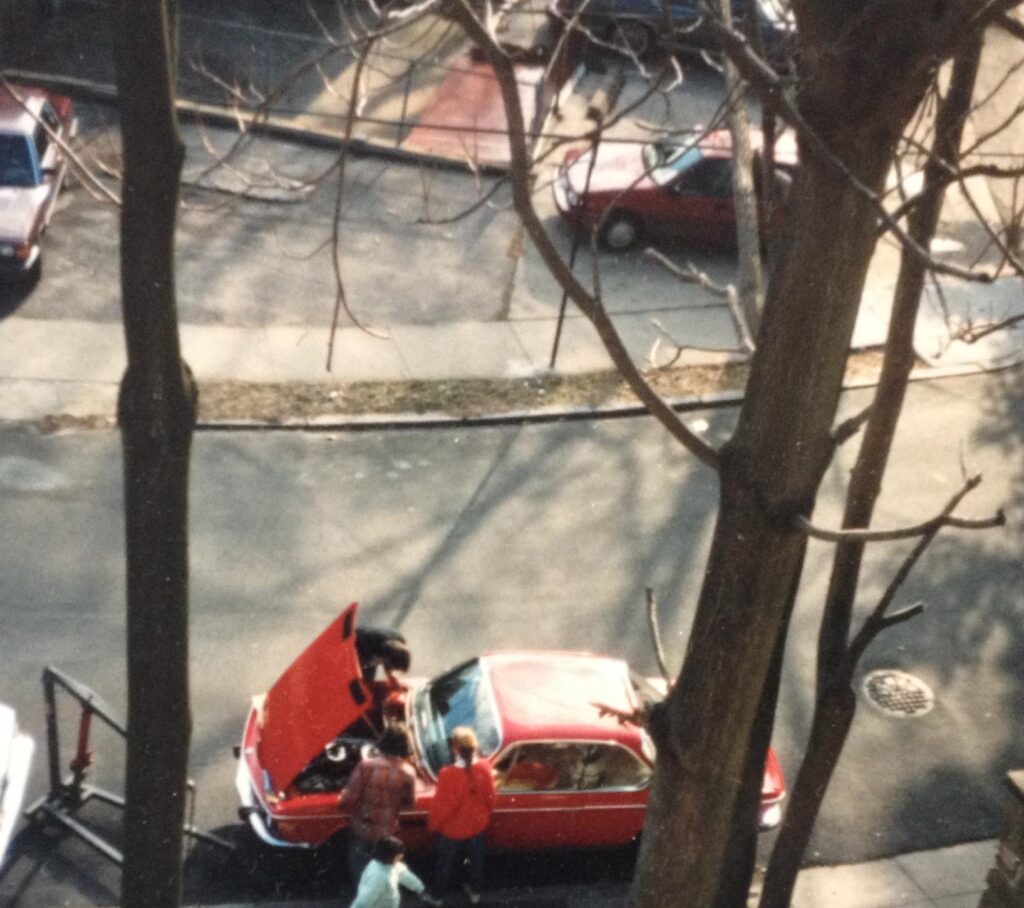
I always have been very good at getting work done in less than mechanic-favorable places.
In 1999, I retrofitted air conditioning into the car. That was followed by an L-Jetronic injection retrofit in 2001. (Yeah, I should’ve just done the Motronic retrofit that came with the engine. Woulda shoulda coulda.) That pair of modifications dramatically improved the car’s comfort and drivability.
Not much happened with the car for the next ten years. Then, in the winter of 2010, I began reading online about the “Vintage at the Vineyard” event in Winson-Salem (now called “the Vintage” and held in Asheville). Through luck, I happened into a set of 16-inch Alpina open-lug wheels and a set of beige cloth Recaros that were very similar in color to the car’s transplanted interior. I installed the wheels and seats, as well as a set of Bilstein HD shocks and struts, and a set of cut springs to hunker the car down slightly. These changes, combined with the fact that the car was actually getting out instead of being hidden, had the effect of reconnecting me with the car.
That first trip to Vintage at the Vineyard was nothing less than transformative. In particular, while I never second-guessed color-changing the car, or using a color from outside BMW’s palette, I’m certainly aware of the argument regarding the effect these things can have on value. But when people who had been reading about the car for decades actually saw it, no one said “Gee, it’s too bad you didn’t do it right.” Instead, the response was a uniform “wow!” One man said, “I never expected The Hack Mechanic’s car to be so nice!”
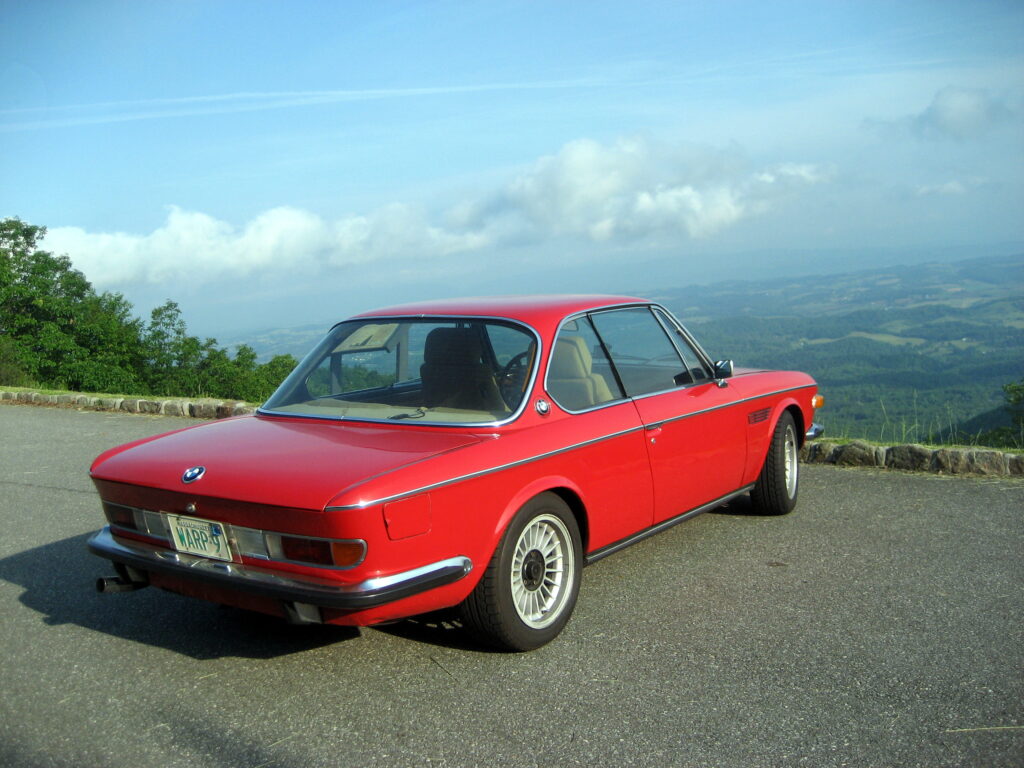
The E9, wearing her new shoes, on the Blue Ridge Parkway on the way to Vintage at the Vineyard in 2010.
One advantage of base coat / clear coat finishes is that when the sun hits them, they can look positively electric. While the E9’s paint has developed some condition issues, when the car is in direct sunlight, it still looks like an at-the-height-of-her-powers flawlessly-accessorized stunning woman for whom every head turns when she walks in the room.
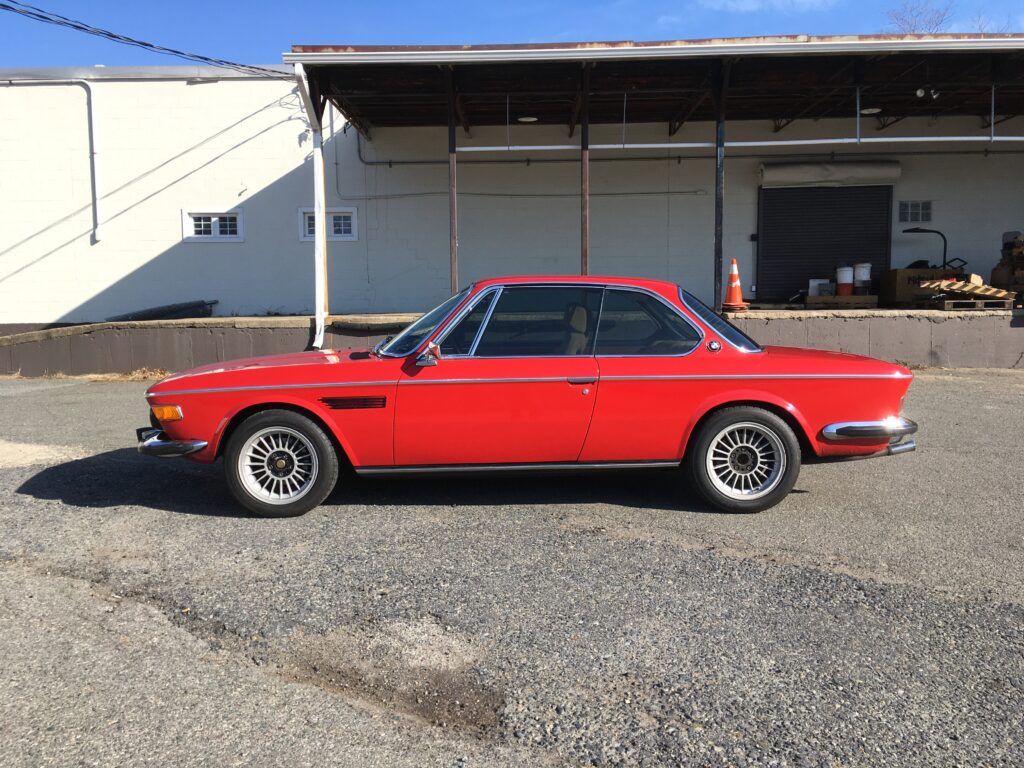
Kapow.
So, I own a rust-free 1973 3.0CSi on which very little is original. It’s painted the wrong color, has the wrong engine and fuel delivery system, and the wrong interior. And you know what? I don’t care. I would never have the connection I have with this car had it stayed Polaris / Navy. I would’ve sold it years ago.
To be clear, restoration is a fool’s game. If you want a pretty shiny car, you should buy a pretty shiny car and not try to make a silk purse out of a sow’s ear. If you can’t afford a pretty shiny car, tough stuff—the world is full of things you can’t have. And it is far easier on the wallet to live with patina. Most of my other cars are of the well-patina’d variety. Whenever anyone uses the word “restore” (or the jaunty “build”), I think “You either don’t have a clue of how much this is going to cost, or you do and you have a lot more money than I do.” Not that there’s anything wrong with that. The E9 is the only car on which I’ve ever had anything remotely approximating an outer-body restoration done, and it’s difficult for me to imagine it ever happening again. Patina is good. Patina is easy to live with. Owning a car with patina is the realistic manifestation of not chasing perfection. And perfection rarely actually made anyone happier.
Best $13,700 I ever spent.—Rob Siegel
____________________________________
Rob’s newest book, The Best of The Hack Mechanic, is available here on Amazon, as are his seven other books. Signed copies can be ordered directly from Rob here.


